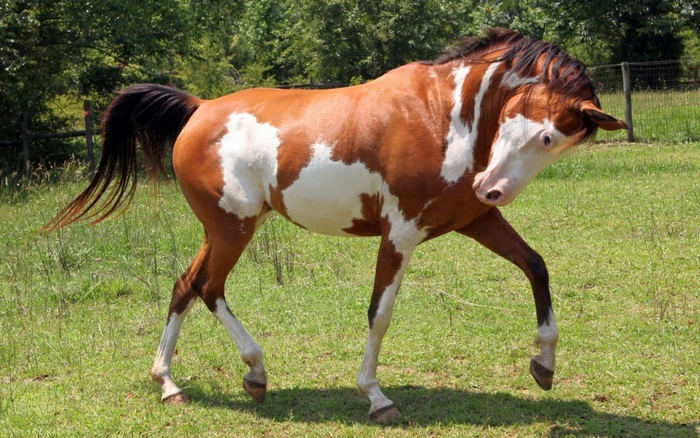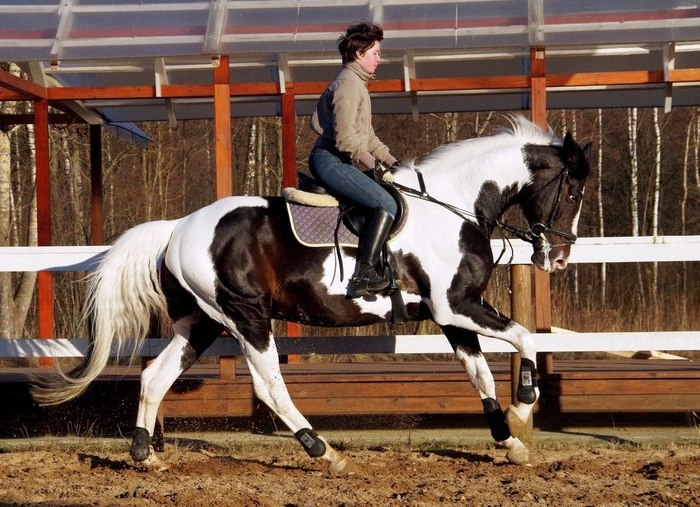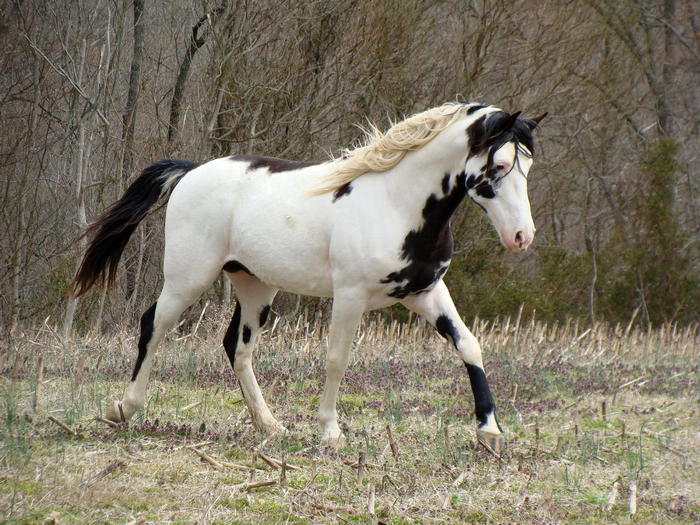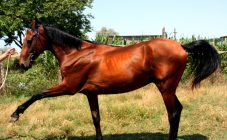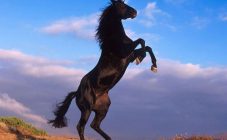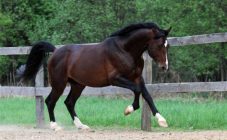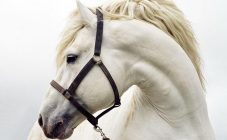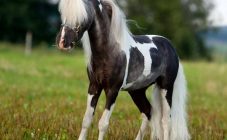Content:
The piebald horse is always in the spotlight, and all thanks to its bright, unusual and even exotic color, which differs from other colors of horses.
A spotted horse is called a piebald, but only if there are exclusively white spots of various sizes and shapes on the body. The history of the origin and features of the suit is the topic of the article.
Origin story
The spotted horse began to arouse interest in ancient times - this is evidenced by ancient Egyptian historical documents. In addition, archaeological excavations have shown that this color was often found in the steppe herds of Mongolia and China.
But the spotted horse is an atypical phenomenon, this is not a color characteristic of horses, and therefore the question arises: where did it come from? Experts in the course of numerous studies have found that these representatives have a gene abnormality that is inherited. It is she who leads to abnormal pigmentation of the horse's skin.
In addition, it has been scientifically proven that different genes are responsible for the color of a specific area of the equine body. Piebald - partial albinism. For this reason, horses of this suit may have a blue color on one or both eyes. There is also a theory of incest with Mongolian horses, among which the very piebald individuals were often found. For this reason, skewbald horses have become common.
In Europe, spotted horses began to be treated with disdain centuries ago. Even in the Middle Ages they were referred to as "gypsy". Their unusual color was considered "cow". The hardest equestrian labor fell on their "shoulders". And this is despite the fact that they could not boast of excellent health, because many of their diseases are at the genetic level. The prospect of breeding skewbald horses did not attract anyone.
As for the American continents, they were treated differently there. Horses were brought to North America by the conquistadors. Most of the horses have gone wild. The extraordinary beauty quickly attracted the attention of local residents. The skewbald horse was a symbol of the Wild West, the Indians were sure that such horses would bring them happiness. The name of the skewbald horses was different, they were called - pinto. A little later, the American breed was formed, which is called the American Paint Horse.
In the middle of the 20th century, a community dedicated to piebald horses was created. Owners and connoisseurs of horses became the founders of the club. Today, horses are used in equestrian tourism, at the ranch, they perform at demonstration events.
Skewbald horse: external features
Often, beginners have a question: what color is a piebald horse? The question is quite common among people who wish to acquire a stallion. A piebald foal can absorb all existing colors. White fragments on the skin can be small, and sometimes cover almost the entire body of the animal, including the tail and mane.
In Russia, there are 4 main colors. They, in fact, are classified based on the suit:
- Gray piebald not very common, or rather, it is generally difficult to meet her.A characteristic feature of these horses is the shade of the mane is grayish-white, the legs, as a rule, are also light. The shape, size and number of light spots may vary. There are also absolutely white horses that have small spots a little darker.
- Red piebald. These horses have a more reddish color of the skin, there are not so many white spots and they are indistinct in outline. Albeit rare, but there are stallions with limbs and mane completely white.
- Black piebald has a beautiful bright contrasting color. The skin is black, white markings are located on them, their number is not very large.
- Bay-piebald. The body of the horse is abundantly covered with white spots, the limbs, mane and tail, as a rule, are also white. Also on the tail and mane there may be red and black strands.
Temper and behavior
The piebald stallion is famous for its docile and calm disposition. In America it is used for exhibitions, and in Russia they help people in every possible way with the housework. Even a child can saddle a well-mannered horse.
Many horse breeders are still concerned about the health of the piebald suit. They cannot boast of good health, a large number of their diseases are already laid down at the level of genes. The weakest representatives are the frame and overro lines (we will talk about them later). If both parents are of this type, as a rule, the offspring has underdeveloped organs of the digestive tract, mainly the intestines. This often leads to the death of the foal. Pathology develops due to the presence of the FR gene in both parents.
Piebald horse: breeds
American horse breeders use their own classification of piebald horses.
Horses belonging to this type are called Pinto, they are united by one common characteristic feature - multi-colored color and blue eyes. By color, they are divided into the following types.
Tabiano
The name comes from the name of the abnormal gene - To. As a rule, horses have dark sides. White spots are round or oval in shape, most often located symmetrically to each other.
The gene can manifest itself in different intensities, so such offspring can even come from monochromatic parents. It is believed that there is another non-allelic gene involved that contributes to spotting.
Overo
Quite a large group of horses that have asymmetrical spots.
It, in turn, is subdivided into three more subgroups:
- Frame overro... The stallion's head is usually monochromatic; white markings are rarely seen. On the body itself, white spots without edging can form in an unlimited number. The light areas do not cross the back. But there are exceptions when white predominates in the horse's color. The limbs are painted in the main color, monochromatic. The tail is also monochromatic, the cause of albinism is the F1 gene.
- Overo SplashedWight. A characteristic feature of such horses is that their color does not have clear boundaries, it seems that the horse has fallen into paint and stuck its muzzle there. White spots can be located on the muzzle, sides. The dark color usually persists on the back and neck. Scientists believe that the SPL gene is the cause of such piebaldness, and the intensity of the appearance of spots will depend on its concentration in the individual.
- Sabino Overo characterized by the formation of white spots on the limbs, quite often they stain the entire leg. Sometimes white spots can be found on the sides and belly.Coloring the head is also acceptable - in this case, the white spot often touches the upper lip. On the markings, the coat is pure white, whitish hairs may also be present on the main body.
Tovero
A unique subgroup that combines the characteristics of Oveiro and Tabiano.
If you mate with each other two breeders, the offspring will acquire the characteristics of both parents. As a rule, the cub inherits the color of the parent whose white spots are more pronounced. But there are exceptions, it is impossible to predict this.
When mating, each parent shares a different mottling gene, so the foal's white markings can be quite unusual. For this reason, there is often confusion in the definition of the stallion species.
Interesting Facts
Due to its unusual color, the piebald suit has many assumptions about its origin and myths:
- Only horses belonging to the Overo group have blue eyes.
In fact, all piebald colors can have blue eyes. It is common for the area around the eyes to be white, which alters the perception of the true color of the eyes. A non-standard iris color does not affect the quality and visual acuity. There are horses that are highly sensitive to sunlight, but vision and eye color have nothing to do with it. - Light spots on skewbald horses are shaded.
Some horses do have this feature, but it is quite rare. This is due to the horse's dark skin tone, which shows through the white hair. - In the course of numerous studies, a unique and only lightening gene has been identified in pinto, which has no analogues pearl. If he is in a homozygous state, then the ginger horse will acquire an apricot hue.
The piebald mare is a unique animal that, in addition to its power, grace and good breeding, demonstrates its unique and inimitable color. In keeping, the animal is not very whimsical, but not everyone can afford it.
